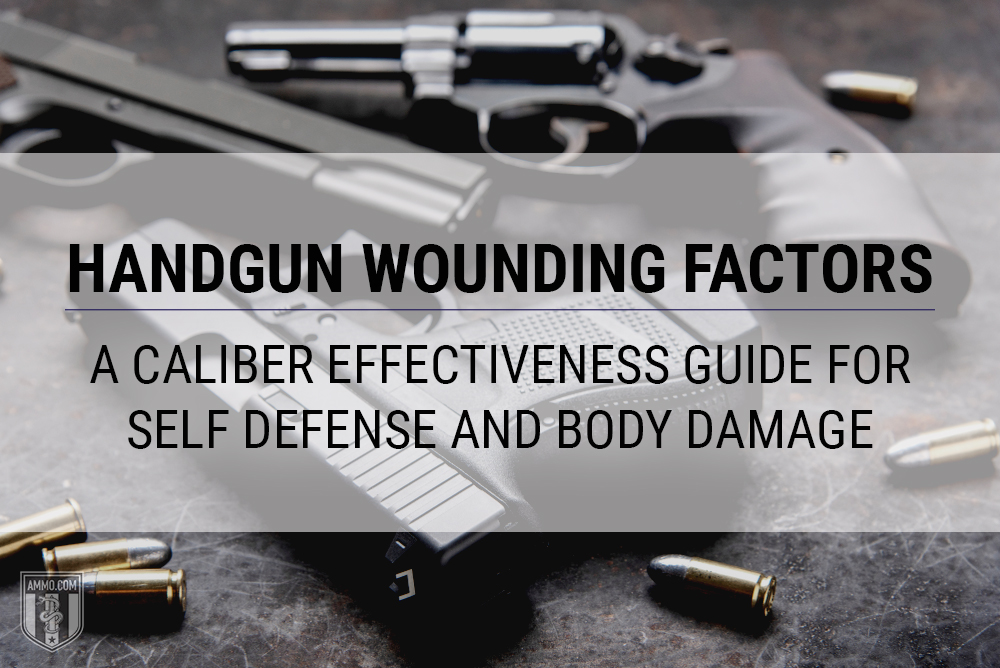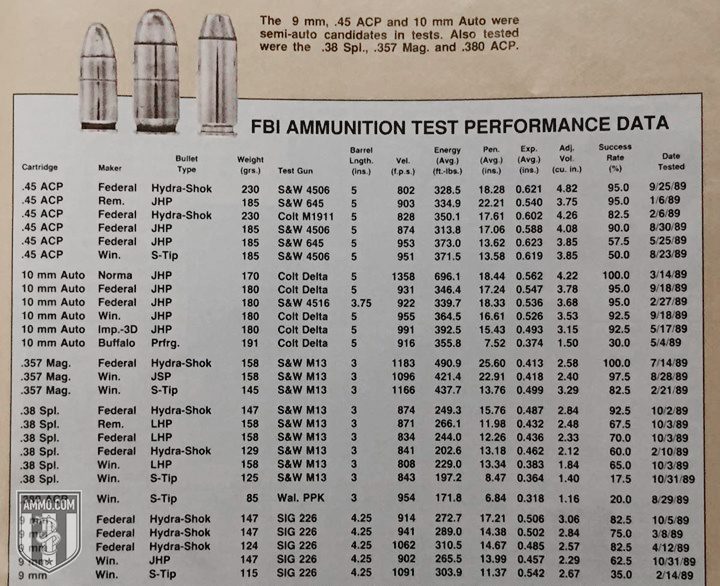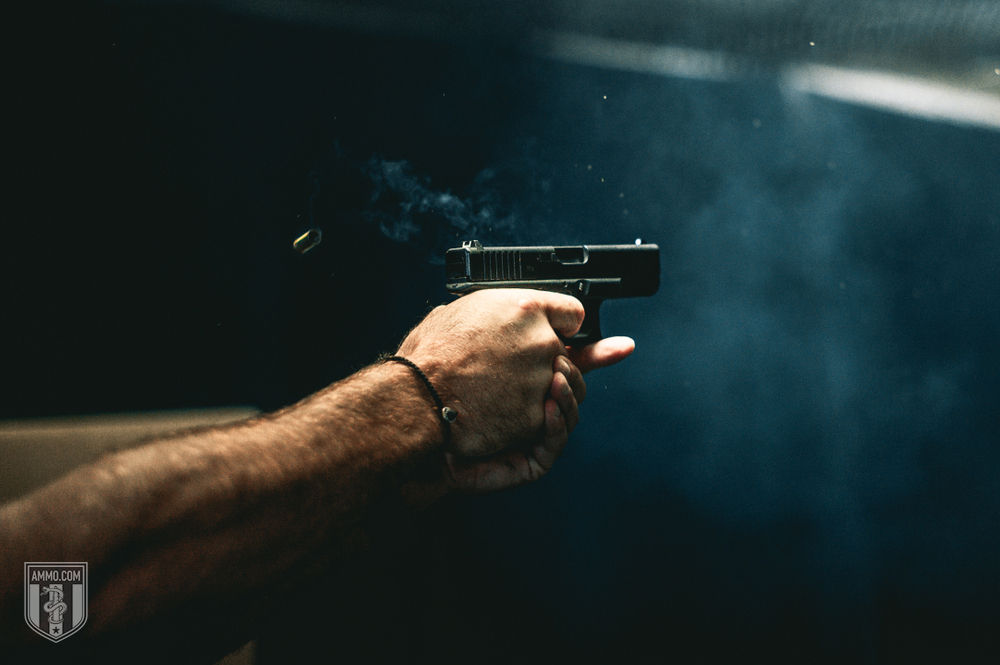Handgun Wounding Factors: A Caliber Effectiveness Guide for Self Defense and Body Damage
You're free to republish or share any of our articles (either in part or in full), which are licensed under a Creative Commons Attribution 4.0 International License. Our only requirement is that you give Ammo.com appropriate credit by linking to the original article. Spread the word; knowledge is power!
 According to a sweeping 2016 survey, there were, at that time, more guns in the hands of Americans than there are cars on the road. Of the nearly 250 million guns owned by Americans at that time, somewhere between 40 and 50 million of them were handguns. Of handgun owners alone, 63 percent owned these for the purpose of protecting themselves against other people, with another 20 percent owning them for protection against animals. The former is by far the leading reason for handgun ownership.
According to a sweeping 2016 survey, there were, at that time, more guns in the hands of Americans than there are cars on the road. Of the nearly 250 million guns owned by Americans at that time, somewhere between 40 and 50 million of them were handguns. Of handgun owners alone, 63 percent owned these for the purpose of protecting themselves against other people, with another 20 percent owning them for protection against animals. The former is by far the leading reason for handgun ownership.
This represents a cultural shift in America. The last time such a broad survey of gun ownership in America was done, long arms ruled the day and Americans were largely interested in weapons for hunting and other sporting uses.
If one keeps a weapon in the home for self defense, we believe that it is a duty to know the weapon inside and out and to train with it regularly. What’s more, for those who are considering purchasing a firearm for home defense, but have not yet done so, it is important to know what kind of firearm is appropriate for your needs.
All of this leads directly to the question of handgun wounding factors: the effectiveness of a handgun, lethality by caliber, and stopping power are all important considerations when purchasing a firearm for self defense. There’s no reason to mince words – a handgun for self defense exists to create damage to the human body. With this in mind, we will now explore handgun wounding factors.
Why Handguns?
 Note that buying a handgun for personal protection is not an abstract desire. It has been reported by Heritage about how there are a number of personal protection gun uses that make the news in any given month, but are given a tiny fraction of the attention that mass shooters and other violent gun criminals receive. Just how common are self-defense uses of firearms? The FEE reports that there are between 2.1 and 2.5 million defensive gun uses annually, which means you’re more likely to use a gun in self defense than you are to be killed in a car accident.
Note that buying a handgun for personal protection is not an abstract desire. It has been reported by Heritage about how there are a number of personal protection gun uses that make the news in any given month, but are given a tiny fraction of the attention that mass shooters and other violent gun criminals receive. Just how common are self-defense uses of firearms? The FEE reports that there are between 2.1 and 2.5 million defensive gun uses annually, which means you’re more likely to use a gun in self defense than you are to be killed in a car accident.
When a handgun is bought for personal protection, whether in the home or on the street, its purpose is the application of deadly force to protect your own life, the lives of others, and to prevent serious physical harm. Shooting another person is only done with the intention to, at the very least, incapacitate the subject to protect the physical safety of others. This is why you must choose your weapon carefully and train with it diligently. It is the concept that will underlie this entire article.
If, God forbid, you are ever in a situation where you are required to use your handgun, there is, to put it mildly, a great deal at stake. While there are uninformed opinions regarding stopping power, thankfully, there is also plenty of credible research. Still, the research is not widespread and a great deal of it is not terribly relevant for the average person searching for a reliable self-defense weapon.
In this article, we will present what we believe to be the most credible information regarding wound ballistics from studies conducted by the FBI’s Firearms Training Academy in legendary Quantico, Virginia. While this research is geared toward law enforcement officers, it cuts through the confusion, and provides common-sense, scientifically supported principles by which the effectiveness of self-defense ammunition may more generally be measured. And while it’s not the final word on wound ballistics, it’s an important contribution to what should be an ongoing discussion.
Best Self-Defense Caliber and Damage to the Human Body
Shot placement is often cited as a consideration when choosing the right handgun for self defense and for good reason – it’s definitely important. However, caliber is at least as important and should not be ignored when choosing a weapon. A round put through the central nervous system of a target is likely to be incapacitating regardless of the caliber chosen. If you shoot someone through the skull with a .22 rimfire and penetrate their brain, you will almost certainly immediately incapacitate them. But this doesn’t mean that a 22 rimfire is the best caliber or even a good choice for head shots. It simply means that if you can shoot someone in the head, basically anything will do.
If you find yourself in a legitimate self-defense scenario, you will likely not have the opportunity nor the wherewithal to take a careful and well-aimed shot at your assailant's head. Much more likely is that you will be suddenly and unexpectedly attacked by a rapidly and unpredictably moving target with limited opportunities for counter attack. Poor light and unplanned obstacles are common in real-life self-defense scenarios. There is also the very real factor of life-or-death, fight-or-flight stress.
This is why, when training with a firearm, you should train for the center of mass, regardless of target anatomy or angle. Studies based on law enforcement shootings that are available to us show that only one or two solid torso hits can be expected at best. It is extremely difficult to shoot accurately under such pressure. Multiple hits are extraordinarily unlikely. This is why officers typically carry as many shoulder weapons as possible in their cars. The general plan of attack for officers is to use some weapon other than a handgun. However, for the civilian this is generally an impractical plan for a variety of reasons.
Because of the relatively slim chance of obtaining more than a single torso hit, the ammunition used must maximize the likelihood of immediate incapacitation.
Some of the best handgun calibers for self defense are:
Effectiveness of Bullet Wounds: How Gunshot Wounds Work
 To adequately understand the efficiency of incapacitating a target, we must have some basic understanding of the mechanics of wounding – how damage to the human body works. There are four major handgun founding factors. While each of them has no direct bearing on incapacitation, they must all be considered.
To adequately understand the efficiency of incapacitating a target, we must have some basic understanding of the mechanics of wounding – how damage to the human body works. There are four major handgun founding factors. While each of them has no direct bearing on incapacitation, they must all be considered.
- Penetration measures the tissue through which the projectile passes, and which it disrupts or destroys.
- Permanent cavity measures the volume of space once occupied by tissue that has been destroyed by the passage of the projectile. This is a function of penetration and the frontal area of the projectile. Quite simply, it is the hole left by the passage of the bullet, one component of the wound cavity.
- Temporary cavity measures the expansion of the permanent cavity by stretching due to the transfer of kinetic energy during the projectile’s passage, the second component of the wound cavity.
- Fragmentation describes projectile pieces or secondary fragments of bone which are impelled outward from the permanent cavity and may sever muscle tissues, blood vessels, etc., apart from the permanent cavity. Fragmentation is not necessarily present in every projectile wound. It may or may not occur and can be considered a secondary effect.
Projectiles incapacitate by damaging or destroying the central nervous system, or by causing significant and potentially lethal blood loss. To the extent the wound components cause or increase the effects of these two mechanisms, the likelihood of incapacitation increases. Because of the impracticality of training for headshots, this examination of handgun wounding relative to law enforcement use is focused upon torso wounds and the probable results.
Handgun Wounding Factors
Handgun wounds include the first three of these factors, but generally do not include the fourth. Fragmentation cannot reliably be counted upon with handgun wounds because of the comparatively low velocity of handgun rounds. Only high-velocity rounds (those with an impact velocity of 2,000 feet per second or more) with soft or hollow points reliably offer fragmentation. Handgun velocities top out at around 1,500 fps at the muzzle. To ensure fragmentation would be to make a round so fragile that it would virtually eliminate penetratration.
When fragmentation occurs, the permanent cavity expands rapidly and dramatically. Tearing and rupturing is common in tissue surrounding the wound channel. This makes rifle rounds significantly more damaging than their handgun counterparts.
Keep in mind that fragmentation does sometimes occur, however, it cannot be relied upon. When it does occur, it is not a significant factor in wounding. Temporary cavity is often grossly overrated as a wounding factor, but has historically been one of the primary methods for measuring effectiveness. Indeed, in some studies, such as one conducted by the Law Enforcement Assistance Administration (LEAA), the temporary cavity is assumed to be the primary handgun wounding factor. Rounds were literally ranked on the basis of temporary cavity volume, with penetration and permanent cavity ignored.
This study is thus inherently flawed, as it ranks large shallow wounds above deeper ones. Vital organs sit deep within the human body, so penetration and permanent cavity volume are important factors. What’s more, a temporary cavity measures volume that has been stretched, not volume that has been destroyed. Tissue inside the human body is remarkably elastic, even vital organs such as the lungs, bowels or circulatory system. Without fragmentation, temporary cavity wounds can be relatively minor.
Tissue disruption caused by a handgun bullet is limited to two mechanisms:
- The crush mechanism is simply the hole a bullet creates while passing through tissue. It is a result of penetration and permanent cavity handgun wounding factors and the only mechanism that actually wounds tissue.
- The stretch mechanism refers to tissue that is stretched and is extremely similar to temporary cavitation. For reasons stated above, this is not a mechanism that causes actual wounding to tissue.
What Happens When You Get Shot: Damage to the Human Body
There are two places that we know will incapacitate a man every time they are hit: the brain and the upper spinal column. Everywhere else, you have only a chance of incapacitating your target. There are a number of factors involved, including physical, psychological and physiological, but human bodies are much more durable than is commonly believed.
Only two factors are within your control: the location of the wound and the amount of tissue destroyed.
Physiologically, a highly motivated target can only be destroyed by hitting the brain or the upper spinal column. While massive trauma to the circulatory system can cause incapacitation, this takes time. When dealing with a highly motivated target, milliseconds matter. There is enough blood within the brain at any time to support conscious, voluntary action for 10 to 15 seconds – even in the event of the destruction of the heart itself.
Indeed, physiological factors play a very small part in rapid incapacitation of a target. This is because, unless you get a central nervous system hit – extremely difficult – there is no physiological reason a target would become incapacitated until blood loss and extreme loss of blood pressure occurs.
Pain is generally physiologically irrelevant, but where present often just makes motivated targets angry and thus, more motivated.
Fortunately, physiological factors are often not the deciding factor. Psychological factors play a much greater role. This is what can incapacitate a target, even with a poorly placed torso shot. Awareness of the injury (which often registers before pain), fear of death or greater injury, preconceived notions of what people do when they’re shot, as well as a simple desire to give up can all play a factor in psychologically incapacitating an attacker.
While psychological factors incapacitate more assailants than physiological factors, they are also the primary reason for a failure to incapacitate. There are a number of reasons for a failure to incapacitate, including a lack of awareness of the wound, intense personal fortitude, extreme emotions or physiological effects both natural (adrenaline) or chemically-induced (drugs such as PCP, heroin and cocaine).
Contrary to popular belief, there is no such thing as “knock-down power.” The only thing that can knock a target down is physiological incapacitation or psychological stress.
Lethality by Caliber: What’s the “Best Handgun Caliber” For You?
 The two most important factors to consider, in order of importance, are penetration and permanent cavitation. The round should be able to penetrate the body sufficiently to damage internal organs, even from less-than-ideal angles. For example, a shot through the side of the body must penetrate between 10 to 12 inches to hit the heart. Even a frontal gut shot must penetrate seven or more inches in slender adults for reliable incapacitation.
The two most important factors to consider, in order of importance, are penetration and permanent cavitation. The round should be able to penetrate the body sufficiently to damage internal organs, even from less-than-ideal angles. For example, a shot through the side of the body must penetrate between 10 to 12 inches to hit the heart. Even a frontal gut shot must penetrate seven or more inches in slender adults for reliable incapacitation.
There have been several attempts by ballistics engineers to increase the wounding ability of a round. Of these, the hollow point round is the most common and effective. These are rounds designed to expand upon impact with a soft target. The expansive quality of these rounds creates larger permanent cavities. Still, no one should select a caliber based on the assumption that it will expand sufficiently to incapacitate an assailant.
Ultimately, your selection of a caliber should be based first on the penetration, and second on the unexpanded size of the round. These are the only two factors you can expect to remain constant in any situation. Even minor and common factors can significantly impact the wounding ability of a round, including damage to a hollow point through contact with any intervening material, from glass to bone. Clothing fibers can wrap the nose of a projectile, preventing expansion. Shorter barrels or longer range of initial impact will likewise decrease the possibility of expansion.
The concern that a round will pass through an assailant and harm an innocent bystander is largely exaggerated. Most rounds fired do not hit anyone at all. Rounds that do not hit the intended target are obviously more dangerous to bystanders than a round that hits the target. Indeed, you and bystanders in the immediate area are much more endangered by rounds that do not penetrate sufficiently than by rounds that “overpenetrate.”
Shooting Incident Analyses
Unfortunately, there is no valid, scientific method of analyzing actual shooting incidents. All studies are greatly flawed and there is no serious pursuit of better studies due to the enormous difficulty, if not impossibility, of scientifically analyzing real-life shooting incidents. What we do know, however, is that when most people are shot, they fall down. So any caliber is better than none.
But you still want the best caliber possible, because while people are disposed to fall down when shot, not every target does. And while you might think that lethality by caliber is the main factor you should be looking for, the simple fact is that while a 22 rimfire is deadly, it is far from the best round for incapacitating an assailant in the here and now. The question isn’t “how many people die from being hit with a certain a round,” but rather “what do they do immediately after being hit?”
We do, however, have reliable information from labs with regard to how much tissue rounds destroy. This is important because of permanent cavitation: The greater amount of tissue that is destroyed, the greater chance of incapacitation, all other factors being equal. No lab test can tell you how likely a round is to drop an assailant, but they can tell you how destructive a round is upon impact, which is the best metric you’re going to get.
Every shooting incident is a unique and unreplicable event. We cannot recreate these or even reliably use the data. We can, however, find the most destructive round we can handle and train with it regularly.
Anything else is a simple failure to prepare.
Self Defense
- Arming Yourself: A Woman's Guide to Self Defense and Concealed Carry (CCW)
- Protecting Your Family: A Parent's Guide to Self Defense and Concealed Carry (CCW)
- Arming the Elderly: A Self-Defense Guide for Senior Citizens
- Holsters for Self Defense: A Guide to Carrying Concealed
- Arming Toddlers and The "Kinder-Guardians" Program: A Shamefully Bad Idea
- Handgun Wounding Factors: A Caliber Effectiveness Guide for Self Defense and Body Damage
- Self Defense for LGBT: Self-Protection and Concealed Carry (CCW) for the LGBT Community
- Arming the Disabled: A Self-Defense and Concealed Carry Guide for People With Disabilities
